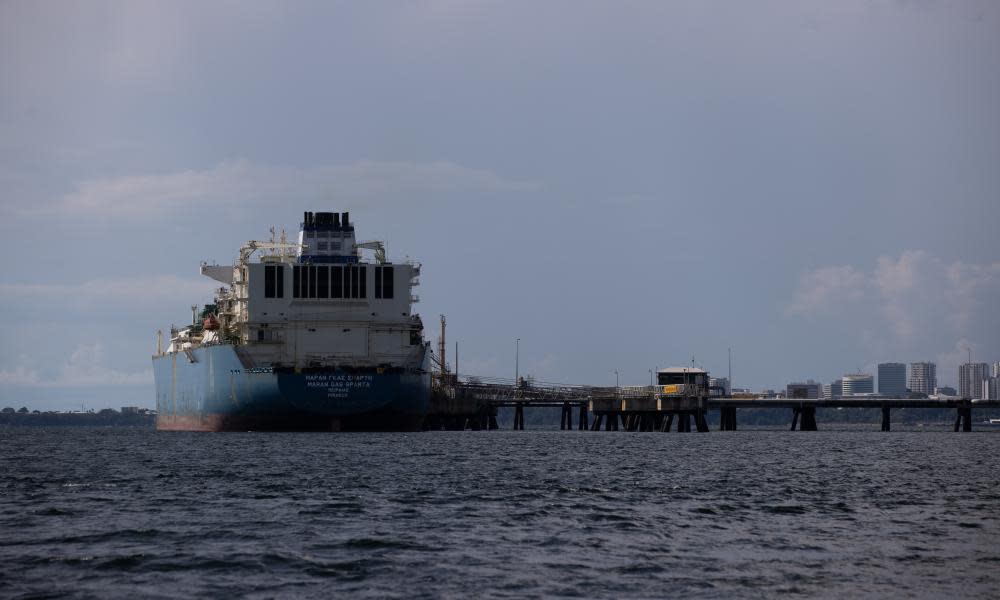Albanese government knew ‘sustainable’ Darwin harbour project would be used for gas export, documents show

The federal government knew wharves at the proposed “sustainable” Middle Arm development on Darwin harbour would be used for gas export, documents released under freedom of information show.
Briefing materials from the Northern Territory government released to the Environment Centre of the NT have prompted fresh questions about the Albanese government’s $1.5bn stake in the project, which both governments have labelled a sustainable development precinct.
Related: Darwin’s ‘sustainable’ Middle Arm development is key to huge fossil fuel projects, documents show
The federal minister for infrastructure, Catherine King, has previously said the federal government’s investment in Middle Arm is “not a subsidy for fossil fuels” but rather “an important way of setting up our economy for a sustainable future”.
But a conceptual drawing by the NT government that formed part of an incoming minister briefing prepared by the federal infrastructure department before last year’s election shows the gas industry would benefit from the proposed federally funded marine infrastructure.
In the drawing, four of five proposed wharves are labelled for shipping of products including LNG (liquefied natural gas), methanol, ethylene, ammonia and “clean petroleum”. The remaining wharf is labelled “hydrogen”.
The drawing was for what the NT government described as a “balanced scenario” it was pursuing at Middle Arm, which would feature gas, petrochemicals, blue and green hydrogen, critical minerals and carbon capture and storage.
Two other possible scenarios were prepared, a “future fuels” scenario focused on gas and hydrogen and a “downstream” scenario focused on petrochemicals.
A separate video describes the project as a “globally unique green energy hub” and illustrates plans to link Middle Arm with Sun Cable’s proposed solar farm and the Beetaloo gas basin south of Katherine.
It includes a list of companies that could feature at the Middle Arm site including Tamboran Resources (one of the main companies operating in the Beetaloo), Fortescue Future Industries (Fortescue Metals Group’s clean energy arm), Sun Cable and the critical minerals company TNG, which has since rebranded as Tivan.

The video is undated, but a version was published by the NT government in late 2022 without the list of possible proponents.
The Australian Financial Review reported Wednesday afternoon that Tamboran, FFI and Tivan would feature in an imminent announcement by the NT government about the precinct.
Guardian Australia revealed last month that a briefing to the environment minister, Tanya Plibersek, said the precinct was seen as a “key enabler” for the export of gas from the Beetaloo basin.
Kirsty Howey, the ECNT’s executive director, said the new documents put “beyond doubt” that “everyday Australians are funding a massive fracking export hub in the middle of Darwin harbour to the tune of $1.5bn”.
“By directly subsidising fracking infrastructure at Middle Arm, it’s clear the Albanese government is not merely a passive bystander in new gas projects – it’s a partner in them,” she said.
“Our governments should be acting urgently to cut emissions, not funding carbon bombs that will speed us towards climate collapse.”
A spokeswoman for King said the Middle Arm precinct was “not targeted at one industry over another”.
“It offers opportunities for a range of industries including gas, green hydrogen and renewable storage, as well as advanced manufacturing, carbon capture and storage, minerals processing and other land uses,” she said.
“This investment into common-use enabling infrastructure will give all potential users, in the market the opportunity to grow and thrive rather than a particular company or industry.”
Grant Wilson is the executive chair of Tivan, which has publicly stated it will use the Middle Arm precinct for processing of vanadium for products such as batteries. Wilson said Tivan would make use of the existing infrastructure at Darwin harbour and renewable power to limit its own footprint.
He has raised his concerns about the gas focus of the $1.5bn in federal funding and urged the Albanese government to consider redirecting the money to more sustainable uses at the site.
Related: How is Australia trying to sell a major gas expansion? By badging it ‘sustainable’ | Anne Davies
“I think more of the so-called subsidy should be devoted to land-based infrastructure and to facilitating common use renewables and common use water infrastructure,” Wilson said.
“We are concerned that the social and community reaction to what is effectively subsidising gas infrastructure will be negative for the precinct.”
On Wednesday the NT government outlined plans for a feasibility study for a “clean hydrogen hub” at Middle Arm.
The study, which has federal funding, would be conducted by the gas companies Inpex and Santos, the national science agency CSIRO and the energy consultancy Xodus.
The NT’s chief minister, Natasha Fyles, said Middle Arm “will be a sustainable development precinct for both jobs here in the territory for manufacturing” but also for new technologies to supply energy locally and globally.
She dismissed suggestions Middle Arm was gas-focused.
“There’s a lot of excitement because people can see that this precinct is an opportunity not only for the Northern Territory but an opportunity for Australia and around the world,” she said.

 Yahoo News
Yahoo News 
